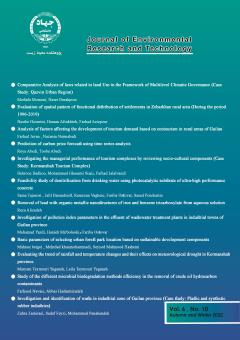-
-
List of Articles
-
Open Access Article
1 - Comparative Analysis of laws related to land Use in the Framework of Multilevel Climatic Governance (Case Study: Qazvin Urban Region)
mostafa momeni naser barakpour -
Open Access Article
2 - Evaluation of spatial pattern of functional distribution of settlements in Zebarkhan rural area (During the period 1375-1398)
Nasibe Hosseini Hasan Afrakhteh Farhad Azizpour -
Open Access Article
3 - Analysis of factors affecting the development of tourism demand based on ecotourism in rural areas of Guilan
Farhad Javan Naimabadi Nazanin -
Open Access Article
4 - Prediction of carbon price forecast using time series analysis
Roya Abedi -
Open Access Article
5 - Investigating the managerial performance of tourism complexes by reviewing socio-cultural components (Case study: Kermanshah Tourism Complex)
Behroz Badko Mohammad Ghasemi Siani Farhad Jalalvandi -
Open Access Article
6 - Feasibility Study of Denitrification of Drinking Water Using Photocatalytic Substrate over Ultra-High Performance Concrete
Sama Tajasosi Jalil Barandoust Ramazan Vagheei Fariba Ostovar saeed poorkareem -
Open Access Article
7 - Removal of lead with metallic organic nanostructures of iron and benzene tricarboxylate from aqueous solution
reza alizadeh -
Open Access Article
8 - Investigation of pollution index parameters in the effluent of wastewater treatment plants in industrial towns of Guilan province
Mohammad Yazdi Hanieh Mirbolooki -
Open Access Article
9 - Basic parameters of selecting urban forest park location based on sustainable development components
MAHNAZ BEIGI mehrdad khanmohammadi Mahmood Hashemi -
Open Access Article
10 - Evaluation of trend of rainfall and temperature changes and their effects on meteorological drought in Kermanshah province
Maryam Teymouri Yeganeh Liela Teymouri Yeganeh -
Open Access Article
11 - Study of the different microbial biodegradation methods efficiency in the removal of crude oil hydrocarbon contaminants
Farhood Navaie Abbas Hashemizadeh -
Open Access Article
12 - Investigation and identification of waste in industrial zone of Guilan province (Case study: Plastic and synthetic rubber industries)
Zahra Zamiraei sadaf feyzi Mohammad panahandeh
-
The rights to this website are owned by the Raimag Press Management System.
Copyright © 2017-2026







